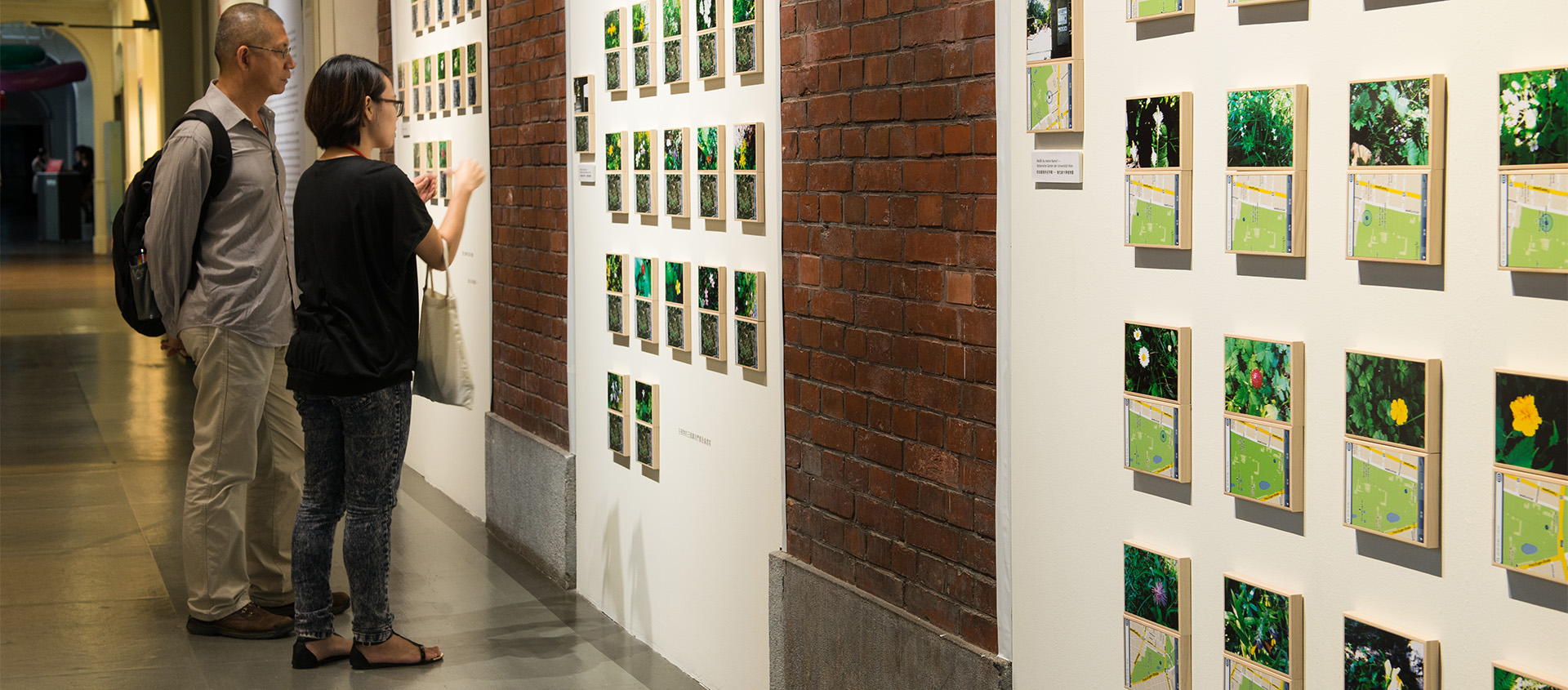

台北當代藝術館 官方網站 Museum of Contemporary Art, Taipei
Monday 星期一
10AM - 6PM



Monday 星期一
10AM - 6PM
EXHIBITIONS & EVENTS 展覽活動

2013 / 08 / 23 Fri.
2013 / 09 / 29 Sun.
10:00 - 18:00
地點
Venue
MoCA Studio
陳建北此次於當代館實驗空間舉行的個展【吾鄉、吾土系列二:你甘知影阮的名─台北植物園】,創作動機緣於他對台灣新世代文化的觀察和體驗,他深深感受到,進入全球化與資訊化的時代之後,台灣新一代青少年對很多事物的看法和想法,明顯已大不同於過往世代,對此現象,在不主觀斷定好壞之前提下,陳建北立意透過個人的創作和展覽,探討不同世代之間的觀點差異和社會情狀,並藉由這些差異,去重新定義台灣與世界的關係。 留學西班牙期間,陳建北在某溪邊第一次看到野生的蘋果樹,雖乏人照料卻結實滿滿,果樹映著清澈溪水的波光,透露出大自然無窮的生機力量,令人動容,也帶給觀者一種莫名的親切與溫暖感覺。一年多前,為了參加一場創作聯展,他突然被兒時的記憶召喚,而有了重訪台北植物園的念頭和行動,沒想到實際進入園區後,真正最引動他審美目光的,竟不是諸多由專家植栽、細心呵護、各有來路的奇花異卉,而是園內路徑旁的一些小草和小花。它們以土生土長、隨機出現的生命樣態,對照著園中因學術研究目的或娛樂觀賞理由而被移植進口的珍貴植物,反而勾起了藝術家進一步了解它們身分的熱情和好奇心。在無法得到任何資訊的當下,陳建北用手機攝影和GPS定位先記錄了這些無名小花、小草的個別「存在」。同年夏天,他到歐洲旅行看展時,也特別參訪了幾個植物園,當他看到各植物園的溝邊路旁同樣可以找到土生的無名花草時,他對植物園的規劃和選擇制度更生困惑,也因此更想透過這些綻放在植物園角落的小花,去凸顯和探討各國植物園的共同盲點。 這個提問「你甘知影阮的名」的展覽,特別聚焦於「台北植物園」裡的美麗小花,除了透過原寸小照片到巨觀化的特寫影像,營造「俯視」和「崇仰」兩種觀看模式、也特意結合了植物園志工及植物學專家等人的訪談影音、名家詩文及相關文獻資料等,希望提供各業對生命/身分的不同體悟和見解,進而導出觀眾對此議題的不同觀點與想像。 The creative motive behind HOME.LAND II : Do You Know My Name? —Taipei Botanical Garden Solo Exhibition by Chen, Chien-pei is based on the artist’s observations of and experiences with the culture of the new generations in Taiwan. Chen feels that as we enter into an era of globalization and information, viewpoints and thoughts of the younger generations in Taiwan are clearly different from that of the previous generation. Without expressing a subjective view on whether the phenomenon is positive or negative, his intention is to explore the differences and social conditions observed in different generations through this exhibition. Through these differences, he wishes to redefine the relationship between Taiwan and the rest of the world. During his time in Spain, Chen once stumbled upon a wild apple tree by a river. Although not tended by anyone, the tree was incredibly fruitful. As its reflection glimmered in the water, nature’s great boundless vitality was revealed. The touching sight gave the passerby an indescribable feeling of warmth and affection. Because of a group exhibition a year ago, Chen was reminded of his childhood memory and revisited the Taipei Botanical Garden. Upon entering into the garden, he found himself more attracted to the wild grass and flowers scattered around the park than the exotic floral and plants that are carefully looked after by the garden’s team of botanists. Compared with the imported rare plants in the garden that are used for research purposes or viewing pleasures, these indigenous flowers and plants that have randomly sprouted have incited the artist’s curiosity and passion to learn more about them. Not able to find any information about these plants, Chen documented these anonymous floral and grassy existences with the camera on his phone and the GPS function. In the summer of the same year, while traveling in Europe, he also visited several botanical gardens. He paid attention to the indigenous anonymous plants in these gardens as well, which spurred further questions about the planning processes and systems used by botanical gardens. He became more determined to use these unknown flowers in these gardens to bring attention to and investigate this common blind spot in botanical gardens around the world. “Do You Know My Name?” is the question in the title and focused on the beautiful tiny flowers found in the Taipei Botanical Garden. In addition to exhibiting photographs of the subjects’ original petite sizes or close-up images of macroscopic views, the exhibition is also designed to offer two viewing perspectives of “looking down” and “looking up.” Furthermore, interviews of the garden’s volunteers and botanists, renowned poems and other related documents are also included in the exhibition, hoping to offer the audience of different backgrounds new understandings and insights into life and identity. The exhibition hopes to encourage the audience to come up with their own viewpoints and visions for the issues presented.
MORE
LESS
陳建北生於上世紀中葉,血源來自台北、南京。青少年成長期全部在嘉義度過,那時的生活經驗和記憶成為他日後的創作泉源,他也因此自許為嘉義人。國立藝專畢業後,他前往西班牙求學,其間主要作品有1989年的「對語」和 1990年的「求緣」。學成返台後以1997年「被囚禁的靈魂」參加威尼斯雙年展。1999年以華山四連棟整個建築空間呈現的作品「介面」,開創影像裝置新局,後因心臟病發作而暫擱創作數年。2011年起開始專注於「吾鄉‧吾土」系列之創制。此次進駐華山藝文特區的「1987─1997」創作及展出,及接下在當代館的個展,是「吾鄉‧吾土」系列的不同篇章。
Born in the middle of last century, Chien-pei Chen comes from a family lineage of both Taipei and Nanjing. He spent most of his adolescent years in Chiayi, and the experiences and memories from that period of his life would later become his greatest inspirations, and because of this connection, he considers himself to be a person of Chiayi descent. After graduating from National Taiwan Academy of Art, he traveled to Spain for further education, and also contributed to the Artist Magazine, with articles on exhibitions in Europe and the U.S. At the same time, he became devoted in making art, including some of his iconic works such as Conversation (1989) and Praying for Heaven's Charms (1990). In 1994, he returned to Taiwan upon completing his education abroad and began teaching and continued with artistic career. He was invited to exhibit his work, Imprisoned Soul, at the Taiwan Pavilion of the Venice Biennial in 1997.
CLOSE
CLOSE
著作權聲明
台北當代藝術館尊重他人著作權,台北當代藝術館服務條款亦明定,網友使用台北當代藝術館服務不得侵害他人之著作權,因此,台北當代藝術館呼籲使用者同樣尊重他人之著作權。如果您認為台北當代藝術館網站中之任何網頁內容或網友使用台北當代藝術館服務已侵害您的著作權,建議您利用本處理辦法提出檢舉,台北當代藝術館客服中心將儘速為您處理:
若台北當代藝術館網站中之任何網頁內容或網友使用台北當代藝術館服務已侵害您的著作權,請您填寫:「 著作權侵權通知書」,且依該通知書所載提供下列資料及聲明,並以傳真的方式通知台北當代藝術館:
1、著作權人之簽名、或著作權人之代理人之簽名、相關權利證明文件及著作權之內容,例如:已發行書籍之封面及相關頁面、發表於網路中之網頁內容列印紙本及其網址。
2、侵害著作權之內容所在的網頁及網址。
3、您的聯絡地址、電話等資料。
4、書面聲明您確信該網頁內容的使用行為是未經過著作權人、其代理人或法律的授權。
5、書面聲明您於通知書所載相關資料均為真實,且您是著作權人或著作權人之代理人而為上開聲明。
若台北當代藝術館網站中之任何網頁內容或網友使用台北當代藝術館服務已侵害您的著作權,請您填寫:「 著作權侵權通知書」,且依該通知書所載提供下列資料及聲明,並以傳真的方式通知台北當代藝術館:
1、著作權人之簽名、或著作權人之代理人之簽名、相關權利證明文件及著作權之內容,例如:已發行書籍之封面及相關頁面、發表於網路中之網頁內容列印紙本及其網址。
2、侵害著作權之內容所在的網頁及網址。
3、您的聯絡地址、電話等資料。
4、書面聲明您確信該網頁內容的使用行為是未經過著作權人、其代理人或法律的授權。
5、書面聲明您於通知書所載相關資料均為真實,且您是著作權人或著作權人之代理人而為上開聲明。
隱私權保護政策
台北當代藝術館非常重視用戶的隱私權,因此制訂了隱私權保護政策。請你細讀以下有關隱私權保護政策的內容。
隱私權保護政策的適用範圍
1、隱私權保護政策內容,包括台北當代藝術館如何處理在用戶使用網站服務時收集到的身份識別資料,也包括台北當代藝術館如何處理在商業伙伴與台北當代藝術館合作時分享的任何身份識別資料。
2、隱私權保護政策不適用於台北當代藝術館以外的公司,也不適用於非台北當代藝術館所僱用或管理的人員。
3、台北當代藝術館在你註冊台北當代藝術館帳號、使用台北當代藝術館的產品或服務、瀏覽台北當代藝術館網頁、參加宣傳活動或贈獎遊戲時,台北當代藝術館會收集你的個人識別資料。台北當代藝術館也可以從商業夥伴處取得個人資料。
4、當你在台北當代藝術館註冊時,我們會問及你的姓名、電子郵件地址、出生日期、性別、職位、行業及個人興趣等資料。你在台北當代藝術館註冊成功,並登入使用我們的服務後,我們就會認識你。
5、台北當代藝術館也自動接收並紀錄你瀏覽器上的伺服器數值,包括互聯網協定位址 (IP Address) 、台北當代藝術館cookie中的資料及你要求取用的網頁紀錄。
6、台北當代藝術館會使用資料作以下用途:改進為你提供的廣告及網頁內容、完成你對某項產品的要求及通知你特別活動或新產品。
7、台北當代藝術館不會向任何人出售或出借你的個人識別資料。
8、在以下的情況下,台北當代藝術館會向政府機關、其他人士或公司提供你的個人識別資料:與其他人士或公司共用資料前取得你的同意。
9、需要與其他人士或公司共用你的資料,才能夠提供你要求的產品或服務。
10、向代表台北當代藝術館提供服務或產品的公司提供資料,以便向你提供產品或服務 (若我們沒有事先通知你,這些公司均無權使用我們提供的個人資料,作提供產品或服務以外的其他用途)。
11、應遵守法令或政府機關的要求。
12、我們發覺你在網站上的行為違反 台北當代藝術館服務條款或產品、服務的特定使用指南。
13、其他依「個人資料保護法」或政府法令應公開之資料。
14、為了保護使用者個人隱私, 我們無法為您查詢其他使用者的帳號資料,請您見諒!若您有相關法律上問題需查閱他人資料時,請務必向警政單位提出告訴,我們將全力配合警政單位調查並提供所有相關資料,以協助調查及破案!
15、 台北當代藝術館會到你的電腦設定並取用台北當代藝術館cookie。
16、台北當代藝術館容許在我們網頁上擺放廣告的廠商到你的電腦設定並取用cookie。其他公司將根據其自訂的隱私權保護政策,而並非本政策使用其cookie。其他廣告商或公司不能提取台北當代藝術館的cookie。
17、當台北當代藝術館進行與其產品及服務有關的工作時,會使用 web beacons 進入我們的網站網絡,提取cookie使用。
18、台北當代藝術館賦予你在任何時候修改個人台北當代藝術館帳號資料及偏好設定的權力,包括接受台北當代藝術館通知你特別活動或新產品的決定權。